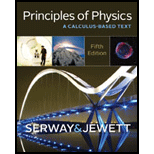
(a)
Rate at which air conditioner remove energy.
(a)
Answer to Problem 55P
The energy is
Explanation of Solution
Air conditioner removes its energy in the form of heat from the cold reservoir.
Write the equation for coefficient of performance.
Here
The efficiency is given as
Here
Divide the numerator and denominator of (II) with
Rewrite (III) in terms of
Conclusion:
Substitute
Substitute
The energy is
(b)
Power required for input work.
(b)
Answer to Problem 55P
The input work is
Explanation of Solution
Write the equation for work done by the engine
Divide (V) with
Conclusion:
Substitute
The input work is
(c)
The change in entropy.
(c)
Answer to Problem 55P
The net entropy change is
Explanation of Solution
The hot reservoir increases in entropy by
The cold reservoir decreases its entropy by
Write the equation for change in entropy
Conclusion:
Substitute
The net entropy change is
(d)
Fractional change in
(d)
Answer to Problem 55P
The fractional change is to drop by
Explanation of Solution
Using (I) find the
Then the actual
Take the ratio of
Conclusion:
Substitute
Substitute
Therefore, the fractional change is to drop by
Want to see more full solutions like this?
Chapter 18 Solutions
Principles of Physics
- Find the work done in the quasi-static processes shown below. The states are given as (p, V) values for the points in the PV plane: 1 (3 atm, 4 L), 2 (3 atm, 6 L), 3 (5 atm, 4 L), 4 (2 atm, 6 L), 5 (4 atm, 2 L), 6 (5 atm, 5 L) and 7 (2 atm, 5 L).arrow_forwardConsider cyclic processes completely characterized by each of the following net energy inputs and outputs. In each case, the energy transfers listed are the only ones occurring. Classify each process as (a) possible, (b) impossible according to the first law of thermodynamics, (c) impossible according to the second law of thermodynamics, or (d) impossible according to both the first and second laws. (i) Input is 5 J of work, and output is 4 J of work. (ii) Input is 5 J of work, and output is 5 J of energy transferred by heat. (iii) Input is 5 J of energy transferred by electrical transmission, and output is 6 J of work. (iv) Input is 5 J of energy transferred by heat, and output is 5 J of energy transferred by heat. (v) Input is 5 J of energy transferred by heat, and output is 5 J of work. (vi) Input is 5 J of energy transferred by heat, and output is 3 J of work plus 2 J of energy transferred by heat.arrow_forwardWhich of the following is true for the entropy change of a system that undergoes a reversible, adiabatic process? (a) S 0 (b) S = 0 (c) S 0arrow_forward
- True or False: The entropy change in an adiabatic process must be zero because Q = 0.arrow_forwardCalculate the net work output (in J) of a heat engine following path ABCDA in the figure, where V1 = 1.5 ✕ 10−3 m3 and V2 = 6.0 ✕ 10−3 m3.arrow_forwardA Carnot engine operates between the temperatures Th = 1.00 x 102°C and Tc = 20.0°C. By what factor does the theoretical efficiency increase if the temperature of the hot reservoir is increased to 5.50 x 102°C?arrow_forward
- By operating a reversible thermal machine with an ideal gas as the working substance in a Carnot cycle (see figure) and measuring the ratio Q_F /Q_Q , we can calculate: (a) n, the number of mols of the ideal gas.b) the ratio V₂ /V₃c) the ratio P₁ / P₄d) the ratio (P₁ V₁) / (P₃ V₃)(e) the value of Avogadro's number.f) None of the above.arrow_forwardWhat is the efficiency of an ideal heat engine that operates on a Carnot cycle between 70 °F and 1000 °F? Group of answer choices 64.70% 62.70% 61.70% 63.70%arrow_forward0.5 moles of cinnamaldehyde gas that has an initial volume of ten liters expands under the following conditions: 185°F and 800mmHg external pressure. a. How much work is done? Express your answer in L atm. b. Assuming that the container is cylindrical with a base radius of 10cm and can only expand vertically, how much kinetic energy does a single molecule possesses if it travels from base to base of the expanded cylinder in 10μs? Express your answer in Jarrow_forward
- A certain heat engine performs a cycle described by the curve A→B→C→D→A in the p-V diagram shown in the figure. The segments between the designated points are all straight. The values of the pressures and volumes at the designated points are:Randomized VariablesVA = 0.95 × 10-3 m3VB = 3.6 × 10-3 m3pA = 2.55 × 106 N/m2pB = 1.95 × 106 N/m2pC = 0.75 × 106 N/m2pD = 1.48 × 106 N/m2 Calculate the net work output of the heat engine, in joules, over a single cycle of operation.arrow_forwardThe temperature of n moles of an ideal gas changes from T1T1 to T2T2 in a quasi-static adiabatic transition. Show that the work done by the gas is given by W=nRγ−1(T1−T2).arrow_forwardFind the amount of work W done on the gas during the entire process? express answer in terms of some or all of the variables p and V W = ?arrow_forward
 Principles of Physics: A Calculus-Based TextPhysicsISBN:9781133104261Author:Raymond A. Serway, John W. JewettPublisher:Cengage Learning
Principles of Physics: A Calculus-Based TextPhysicsISBN:9781133104261Author:Raymond A. Serway, John W. JewettPublisher:Cengage Learning
 Physics for Scientists and Engineers, Technology ...PhysicsISBN:9781305116399Author:Raymond A. Serway, John W. JewettPublisher:Cengage Learning
Physics for Scientists and Engineers, Technology ...PhysicsISBN:9781305116399Author:Raymond A. Serway, John W. JewettPublisher:Cengage Learning


